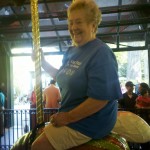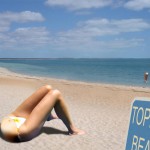Meeting the Ice-Cure family in Israel
By Muriel J. Smith
Editor’s note: In this fifth and final article in her series about her breakthrough treatment for breast cancer, Muriel Smith shares her visit to the Israeli company, Ice-Cure Medical that invented the procedure. Paint the Town Pink

Israeli Ice-Cure Medial staff with Muriel Smith at the cyroablation console, with one of the gifts Muriel brought for the staff to remind them where Centra State Medical Center is. Standing left to right: Maya Yurista- QA Manager, Odelya Eliyahu- Office Manager, Ravit Attali- Clinical Manager, Muriel, Gabriel Cohen- VP R&D Manager, Iris Firer- Accountant, Shahaf Yehuda -Production
My trip to Israel went off without a hitch. Traveling with friends from Our Lady of Perpetual Help/St. Agnes parish, on a tour with a travel company which had previously taken me to Greece, Turkey, Ireland, and Italy, the trip could only be made more exciting for me now that I knew I would be meeting with the people who had invented the procedure and equipment to perform cryoablation…freezing to death the breast cancer that had been discovered only 47 days before it was ablated.
Sue Jebsen, the nurse who traveled the United States with the equipment used in this trial procedure, and Will Irby, Ice-Cure Medical’s key person in the USA, had made all the necessary contacts and explained to me that while the staff in Israel had seen and spoken with physicians who had done the procedure, they had never had the opportunity to meet with a woman who had undergone it. Sue was in the room when Dr. Kenneth Tomkovich had performed the approximate 45-minute procedure which killed the small tumor in my right breast. It was she who first called that evening to see if I would meet with the staff in Israel while on my trip.
It was going to be an exciting time for all of us. Armed with the schedule of my events in Israel that I had given them, Will, in Tennessee, contacted the folks in Israel to set up a mutually convenient date and time. He provided me with the names and titles of the staff I was going to meet…everyone from Hezi Himelfarb, the CEO, to Elizabeth Sadka, the VP of clinical studies, while at the same time keeping the Israeli personnel informed of my itinerary. Through letters and e-mails, we finally agreed on a date and time; a staff member from Ice Cure Medical would pick me up at my hotel, bring me to the office for a tour, meeting, lunch, and then deliver me back to wherever my group was going to be late in the afternoon so I could continue my tour. Meirav Dudek, the vice president and CFO e-mailed me to apologize for the fact she would be in Japan and regretfully could not be there to meet me. But, she added, “Gaby and Elizabeth will be happy to meet you on your availability.”
I was beginning to love these people already. Not only had they invented what could well cut down on the number of surgeries necessary for women with breast cancer, but the CEO was apologizing for not being able to be in Israel at the time I would be there. And I was on a first name basis with the inventors!
There’s an interesting sidebar to this story that I did not realize until after I had met with my new Israeli friends. It involves how much they went out of their way to arrange the meeting, but we’ll talk about that later.
Looking at the map, I could see where Ice Cure Medical location in Israel was in Caesarea, perhaps a half hour drive from Bethlehem where our group would be staying for three nights, after our first three nights in Tiberius, which was two hours further by car from Caesarea. So when Elizabeth left word at the hotel that Sam, an employee, would be picking me up in Tiberius, I figured it was their schedules that dictated the day and time while I was staying at the more distant location.
Sam, who, when he is not coming from his home in Nazareth to pick up a breast cancer survivor to bring to his company’s main office, is a charming father of two youngsters, and one of the professionals at Ice Cure. We exchanged introductions and pleasantries at the hotel on the arranged morning, before I enjoyed a thoroughly spectacular auto tour of a good part of Israel, all the while chatting with Sam about his fairly frequent trips to the USA on company business.
Once in Caesarea, we went to the second floor of the professional building in an industrial park where Ice Cure Medical is located. I was swarmed by a smiling, happy, excited staff eager to make me feel at home. Led by Elizabeth, I met all of the 16 people employed at the office, all brilliant, for the most part young scientists and nurses who speak perfect English and are gracious beyond belief. Spread on the table in the conference room where we chatted were beverages, glasses and bowls of Middle Eastern finger foods, including dried fruits and sugared walnuts. The crew took me through their entire office, finally into the room where the ablation console was set up, so I could meet everyone and they could demonstrate to me precisely how the system had worked on my body.
A couple of hours later, with me well versed and effusive in thanks for their input and work, they said they were taking me to lunch before my trip back to Mount Tabor, where my travel group was visiting the site where Christ was transfigured before Peter, James and John.
Lunch was elegant, fun, memorable, and so filling it was more like a full dinner, complete with several courses, all served while we sat at a table overlooking the Mediterranean Sea. We left each other with hugs, kisses, warm words, and all realizing we indeed had each made new friends.
Sam drove the 90 minutes to bring me to Mount Tabor and re-united me with my tour group. It was the most memorable day of a memorable trip.
It was only after I questioned why they chose to pick me up in Tiberius rather than Bethlehem which was so much closer to their headquarters, that I realized what Israeli citizens endure on an everyday basis. With the country divided between Israel and Palestine, Israelis are not permitted in Palestinian territory. There are four foot high signs along the roads, and barbed wire fences, all warning Israelis of this restriction and further reminding them they could be shot should they cross that border. While we were in Bethlehem, and while we as Americans were never in any danger, our local tour guide, an Israeli, had to get off the bus before we crossed into Palestine. But my hosts at Ice Cure Medical, since they could not come to pick me up in Palestinian controlled territory, chose to travel the greater distance rather than have me find my own way or use other means to visit them in Caesarea.
Today, I am cancer free without the need for surgery. Because I had a mammography and the tumor was detected very early, I do not need either chemo therapy or radiation. I’m still discussing with my medical team whether there really is a need for me to take an estrogen blocker pill for the next five years. I’ve had one meeting with Dr. Mary Martucci, the surgical oncologist and director of the Women’s Center at Centra State Medical Center who oversees this entire trial, and plan on seeing her again in a month. I have an appointment in August for my first post-ablation mammography, and have agreed…indeed at this point, eagerly endorsed….the trial requirement that I have a mammography annually for the next five years.
I do not know how long the trial will last; hopefully the first phase of it will be completed this year. I do not know whether this feisty little Israeli company with its young and ambitious staff will have the necessary funding to promote what is definitely a procedure on the cutting edge…no pun intended….of cancer cures.
All I know is that I was at the right place at the right time to have breast cancer. And I hope my experience will help put the world one step closer to ridding this awful disease from the face of the earth.










Final installment of an incredible series. Brave, experimental, instructive and inspiring. Thank you Muriel Smuth for such a fascinating, well written piece about such a personal journey.